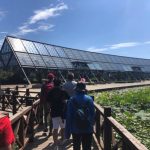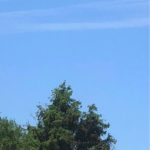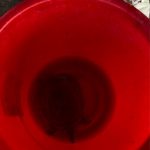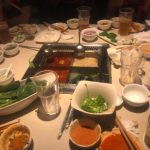August 24th, 2018
Hot, sunny
Vicki Zhang, Zhenglin Yu
2018年8月24日
天气:晴
地点:崇明岛东滩湿地
作者:Zhenglin 和 Vicki
Our day started off with a delicious buffet breakfast. The professors weren’t lying when they said that the food here is good. And we found forks; eating has never been so efficient!
It was game time when we got to Chongjin Island though. The professors divided us into 3 teams for ‘The Big Hour’, where we tried to see and ID as many bird species as possible. Not to brag, but our team won! Thanks to Allen and Huining’s fast identification skills, Olivia’s quick work with the DSLR and Zhenglin’s sharp eye, we saw 13 native species, including the Eurasian tree swallow, intermediate egret, little egret, and the oriental turtle dove.
After lunch at the Dongtan wetland reserve canteen, we gathered outside and started debated the different conceptions of nature between the Canadian and Chinese students, and compared solutions to ongoing problems. It was emphasized that China does care about nature, but due to the country’s long history and sheer number of people, there are few places that are untouched; nonetheless, there are places in China are virtually untouched. Meanwhile, although Canada has the notion of a pristine wilderness, there are still millennia of Aboriginal history. We concluded that there was no real “correct” solution on how to restore wetlands and care for nature, but it was a stimulating discussion. We also talked about the importance of museums and botanical gardens. Apart from education, museums and botanical gardens function as outreach facets, as archives and as research stations.
We also presented the biology and ecology of our team mascot, of which our groups were named after! They were educational and had some fun twists. The Red-Swamp Crayfish group did a dance, and the Chinese Fire Belly Newt group quizzed us on their species distribution. A common theme was that these species are facing anthropogenic threats. The Yangtze Finless Porpoise uses echolocation for navigation and hunting, but noise pollution will disturb their ecology. The Black Faced Spoonbill is frequently disturbed by humans during mating season. The Yangtze Alligator burrows underground, and since they disrupt agriculture, face human prosecution. Finally, some species were invasive. The Canada Golden Rod is invasive in China since it outcompetes native plants; similarly, the Red-Swamp Crayfish is invasive due to their high fecundity and resilience.
Finally, we visited an organic farm. These farmers employ polyculture, growing rice with soft-shelled turtles and crayfish. This is a mutualistic relationship – the turtles and crayfish eat the insects and weeds, and the rice and floating plants provide shelter and physical structure. The farm has found the optimal total yield per volume of water body, while being ecologically-friendly. Organic fertilization techniques are employed: nitrogen-fixing legumes are grown during the off season, the rice crops are fermented after harvest, and animals excrete waste that naturally fertilize crops. It’s an uphill battle for this farm though, since insects may congregate from other pesticide-spraying farms, affecting yield. Despite this, there are ways to increase revenue through branding. The Ministry of Agriculture’s goal of integrating polyculture in 6.7% of farms in China by 2020 can be reached using this organic farm as a model, and hopefully it will encourage farmers to use sustainable methods and reduce pesticides and fertilizers.
We ended the day with hot pot! It’s a new experience for a lot of our Canadian students, and it was so much fun. Conversation and beer flowed, we watched Ernest eat a lot of meat and ruffage, and we tried a lot of new and delicious foods. We are nearing the end of this field course, and it feels bittersweet, but we are still making the most of these jam-packed educational days.
今天早上我们吃完早餐,遍坐上大巴前往令人向往的崇明岛东滩湿地保护区。在路上王教授把我们分成三组,开启了一个观鸟竞赛。 竞赛的内容是让我们三组同学在短短一小时内,通过各种鸟的外部特征和观鸟手册识别尽可能多的鸟类。我,Allen,Huiting,Olivia四人组成了黑杰克组。是不吹不黑,在大家的共同努力下,我们组夺得了头筹,一共认出了13种在东滩湿地栖息的本地鸟类,包括欧亚树燕,中白鹭,小白鹭和斑鸠等。
中午在游客中心吃完饭后,我们在景区外面的阴凉地里对于中加两国的水质保护过了深入的探讨。值得注意的是,中国目前的确花了很大的人力物力来治理水环境,但是由于长久的历史和极其密集的人口,环境问题仍然无法彻底改观。然而,在加拿大,与中国几千年的农耕文明不同,只有少量的原住民在这里生活过一千年左右,所以没有与中国一同严重的污染问题。但是加拿大依然有很多污水和烟囱的排放。我们最后得出结论发现,目前中国的水问题很复杂,不是可以用单一的方法可以轻松解决的。我们还讨论了博物馆和植物园意义,以及他们除了教育以外的数据存留及研究所等的意义。
之后,我们每组还做了关于濒危物种的展示,红塘小龙虾组通过跳舞向我们展示了小龙虾的形态和动作,中国火腹鲵组询问了我们有趣的问题。这次展示的主题是濒危物种,所有展示的物种都是在中国或者加拿大濒临灭绝和急需保护的。长江江豚通过回声定位进行捕食和导航,但是由于船只螺旋桨或其他人为因素干扰了水生生物的定位能力,导致大量江豚死亡。黑脸琵鹭的交配繁殖经常受到人类的打断。由于扬子鳄的洞穴经常影响人类的作物种植,因此人类与扬子鳄之间的矛盾日益凸显。扬子鳄的数量也因人类的活动在近半个世纪迅速下降。加拿大麒麟草作为入侵物种进入中国,与其相同的是,红塘小龙虾因其较高的繁殖率和生物适应性同样成为了中国的入侵物种。
傍晚,我们一行人走访了位于崇明岛的生态农场,这里的农民将立体化农业引进崇明,一片田里养殖着,鳖,螃蟹,牛蛙,小龙虾以及鱼类。水稻和空心菜等植物为螃蟹等生物提供一个赖以生存的栖息地和避难所,同时,这些动物为植物消灭害虫,相互受益。但是,问题还是存在的,这个生态农场里的水源质量无法得到充分保障,与其相邻农田的害虫及农药也还会飘散到该农场之中。因此,这个农场的产品依然是绿色食品的等级,尚未达到有机食品的标准。中国农业部计划将要于2020年将立体农业的占比落实到6.7%。希望通过国家和农民的共同努力可以减少对化肥和杀虫剂的依赖。
晚上返回市区,我们在海底捞进行了结课几年的宴会。这样的火锅对于很多加拿大的学生还是一个全新的体验。回想本次的实习课程,我们收获了知识,经验,很多可爱认真的同学,还有亲爱的,知识渊博的教授们。我们大家都感觉开心和不虚此行。
- On Chongming, we were located on Xisha, the west side of the island. Inside the building, there was a small section dedicated to describing the ecology and endangerment of the Yangtze alligator, as well as a small cafeteria where we ate lunch after our “Big Hour”. 在崇明岛上,我们走到了西沙,在这里展开我们的观鸟活动。在图中的这个建筑中有一个小小的展览馆,展示着扬子鳄的生存状况和崇明岛所面临的生态困难。
- Can you spot the bird? Can you identify the species? (Hint: it’s a loud one; you’ll probably hear them before you see them.) It’s a long tailed shrike! 你能看到那只鸟吗?(提示,那只鸟非常聒噪,你很容易辨别的他的声音) 那是一只斑鸠!
- This organic farm uses soft-shelled turtles and crayfish in conjunction with rice farming to create a sustainable polyculture. 这是我们看到的生态农场,在这个农场里有鱼,鳖,螃蟹,还有小龙虾,他们一起构成了这里的立体农业环境。
- This is a soft-shelled turtle that is a part of the polyculture of the organic farm. 看到这只鳖了吗?他是这个农场的主要经济收入。
- Hot pot was delicious! We made personal dipping sauces, and had 4 different kinds of soup that we used to cook the meat and ruffage. This was a delicious experience. 这是我们晚上吃的海底捞,加拿大的同学非常喜欢这里自制的酱料,非常美味。





Leave a Reply